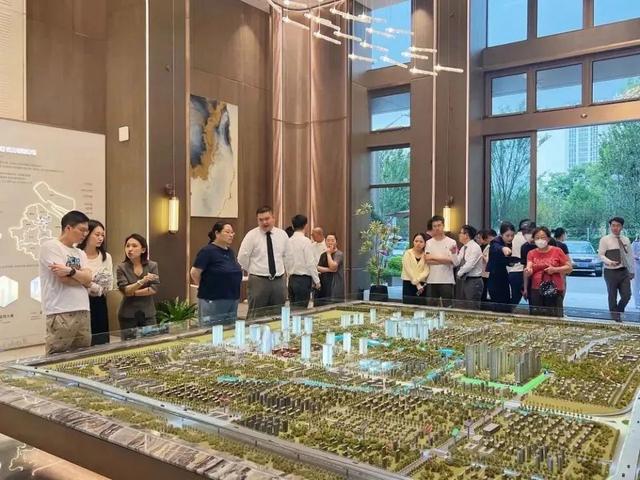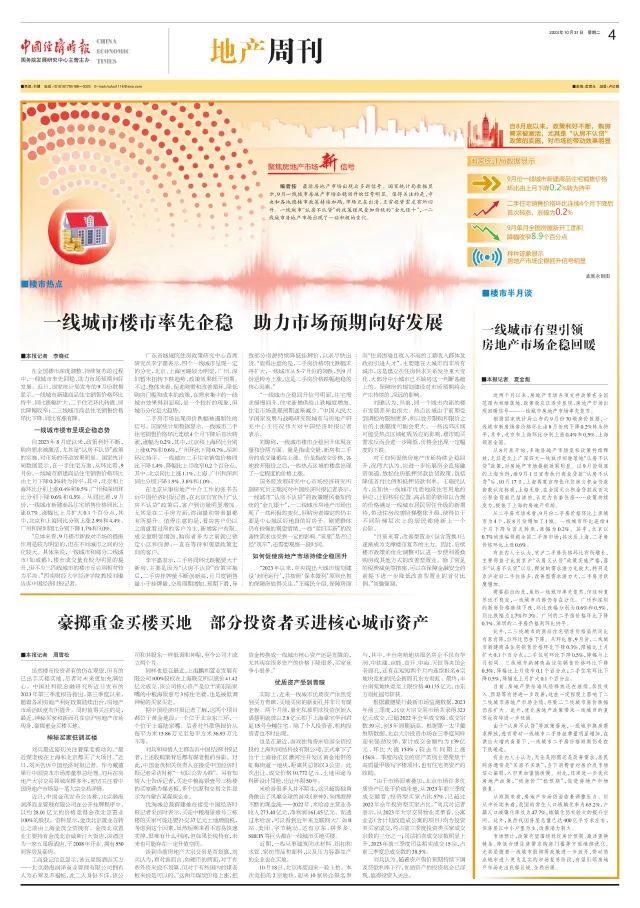

Focus on new signals of real estate market
editorial comment/note
Recently, many new signals have appeared in the real estate market. According to the data of the National Bureau of Statistics, the signal that the real estate market in first-tier cities stabilized and rebounded in September was obvious. It is worth noting that the central and local policies to stabilize the property market continue to increase, the market is clearing, and normal investment demand has rebounded. In first-tier cities, the policy of "recognizing housing but not loans" is superimposed on the traditional "golden nine and silver ten", and some positive changes have taken place in the real estate market in first-and second-tier cities.
Half-monthly talk on property market

Image source/Xinhua News Agency
■ China Economic Times reporter Xia jinbiao
In the past two months, various support policies for the real estate market have been implemented nationwide, and the policy effects are gradually emerging. The real estate market is showing signs of recovery-the real estate market in first-tier cities is the first to recover.
According to the housing price data of 70 cities published by the National Bureau of Statistics in September, the sales price of new houses in first-tier cities turned flat from 0.2% in August, with Beijing and Shanghai rising by 0.4% and 0.5% respectively, with Shanghai leading the country.
Since the end of August, the easing policies of the real estate market in many places have been continuously released. In particular, the four first-tier cities in the north, Guangzhou and Shenzhen have successively implemented the policy of "recognizing houses but not loans", which has obviously boosted the real estate market. Take Shanghai, which led the rise in September, as an example. Following the announcement of the implementation of commercial loans on September 1, on October 17, Shanghai announced the optimization of the criteria for determining the number of housing provident fund loans. If Shanghai has no housing, no provident fund loans in the country or the first provident fund loans have been settled, it will be recognized as the first set of housing … The policy has been continuously exerted, boosting the Shanghai real estate market.
From the perspective of the second-hand housing market, the price of second-hand housing rose by four cities in September, an increase of one city compared with August. First-tier cities turned up for the first time after falling for four consecutive months, with an increase of 0.2%. Among them, Beijing led the national second-hand housing market with an increase of 0.7%; Followed by Shanghai, the price of second-hand housing rose by 0.6%.
Some insiders believe that the price of second-hand houses in Beijing and Shanghai has increased month-on-month, mainly due to the strict implementation of the policy of "recognizing houses and recognizing loans" in Beijing and Shanghai. After the implementation of "recognizing houses but not recognizing loans", the demand potential released is relatively large, especially in Beijing and Shanghai. There are many old second-hand houses, and there is great potential for improved demand, and the activity of second-hand houses has increased.
It should be pointed out that although first-tier cities take the lead in recovery, this recovery is still unstable, and there are still divisions within first-tier cities. The prices of new houses in Guangzhou and Shenzhen continued to fall, with a month-on-month decrease of 0.6% and 0.5% respectively, and a year-on-year decrease of 1.7% and 3%. The price of second-hand houses in Guangzhou decreased by 0.7% month-on-month, while the price of second-hand houses in Shenzhen was flat.
In addition, although the sales price of commercial housing in second-and third-tier cities has increased and decreased year-on-year, the chain is still declining. From the ring comparison, in September, the sales price of new commercial housing in second-tier cities decreased by 0.3% from the previous month, and the decline rate was 0.1 percentage points higher than that of the previous month. Second-hand housing decreased by 0.5% month-on-month, the same as last month. The sales price of new commercial housing in third-tier cities decreased by 0.3% month-on-month, and the decline rate narrowed by 0.1 percentage point from last month; Second-hand housing decreased by 0.5% month-on-month, and the decline rate was 0.1 percentage point higher than that of last month.
At present, the risk release of the real estate supply side continues, and residents’ income and expectations need to be further improved, which has affected the stabilization of the real estate market in second-and third-tier cities to a certain extent, resulting in the decline in house prices in second-and third-tier cities. In addition, the recovery of first-tier cities brought by optimizing real estate policies needs to be further stabilized.
Due to the implementation of policies such as "recognizing houses but not loans", the demand for housing replacement in first-tier cities has been released, which has led to a significant increase in the number of second-hand houses listed in first-tier cities. Under the background of a large increase in supply, the prices of second-hand houses in first-tier cities are still in a downward channel in the short term.
Some insiders believe that whether it is just needed or improving demand, residents usually "buy up and not buy down". At present, consumers’ confidence in housing prices and the market is weak, and they are more cautious and slow to enter the market. In this regard, it is necessary to further optimize the real estate policy, "stabilize housing prices" and "stabilize expectations" and promote the repair of the real estate market.
In the short term, the real estate market is still facing adjustment pressure. However, in the medium and long term, the urbanization rate of permanent residents in China is 65.2%, and the urbanization rate of registered population is only 47.7%, so there is still much room for improvement in urbanization. In addition, although the total number of houses in China has reached about 40 billion square meters, the houses are mainly small and medium-sized units with great improvement potential.
The market expects that the policy is expected to continue to be optimized around stabilizing housing price expectations, activating the replacement chain, and lowering the threshold for reasonable housing demand. In particular, with the further liberalization of policies such as purchase restriction in first-tier cities, hot cities will enter a more solid market recovery stage, which is expected to lead the real estate market out of the bottom area and stabilize and recover.

The copyright of this WeChat official account belongs to China Economic Times. If you reprint or quote the contents of this article, you must obtain permission, and indicate that it was transferred from China Economic Times.
Reporting/feedback